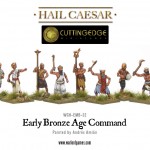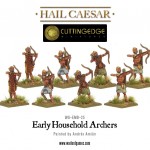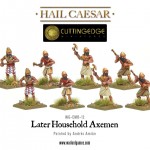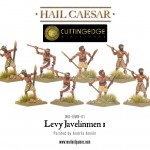A renowned Ancients wargaming expert, archeologist and author, Nigel Stillman is a well respected name in our hobby and we’re delighted to have Nigel writing for us. Here Nigel provides a detailed account of Early Bronze age warfare. Part 1 covers the available sources of information for this long distant era and examines the distinct phases of military development that set apart the armies of the period.
How were battles fought in Ancient Sumer and Akkad?
Within a few generations of the rise of the first cities on the plains of Mesopotamia, in the ancient lands of Sumer and Akkad, the oldest organised armies went into battle. From surviving records and artworks, continuously being revealed by archaeological investigation, we can attempt to reconstruct how these armies were organised and how they fought.
Naram-Sin, the strong, King of Akkad
When the four corners of the world made war on him
He was victorious in nine battles in a single year…
And he captured those kings who had risen against him.
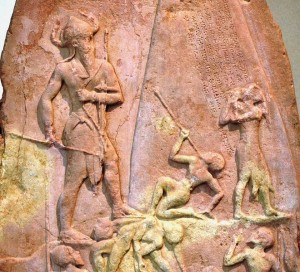
Sources of Information
There are three sources of information for reconstructing how battles were fought in ancient Sumerian and Akkadian times and how the armies were organised and equipped. These are:
- Artefacts. Finds of weaponry and equipment from archaeological excavations in the Middle East, and especially in Mesopotamia. The name itself means ‘the land between the rivers’, these being the Tigris and Euphrates, of course. Most of this region now lies within the modern countries of Syria and Iraq. Agriculture and civilisation developed here several thousand years BC, leading to the rise of numerous cities. Over time, layer upon layer of occupation debris accumulated beneath each city, creating a huge mound, known as a ‘tell’, on top of which stood the latest city. Many such tells are now archaeological sites. Excavation frequently reveals artefacts including weapons of war. For example, in the royal tombs of Ur excavated in the 1920’s, as well as tombs at the site of the ancient city of Kish, remains of four-wheeled battle-carts were uncovered. The actual armaments can be compared to pictorial representations on monuments, which often depict them in what is to us a distorted perspective, helping to clarify such things as the design of a battle-cart. Pottery and bronze models of battle-carts are particularly useful. One wonders whether they were intended for a ritual game of soldiers! Incidentally, a board game was found in the royal tombs of Ur.
- Art. Carvings, inscriptions and depictions of warfare on monuments have also been discovered in excavations. Notable examples include the ‘Stela of the Vultures’ from Lagash and the ‘Standard of Ur’ from the royal tombs. This type of evidence tells us what the troops actually looked like. A victory stela was an inscribed slab of stone erected to record and commemorate a victorious military campaign. It would be set up in the temple precincts in gratitude to the patron god of the city, and as a reminder to future generations to uphold the rights of the city against foes and rivals. Statues of rulers with inscriptions recording their campaigns served a similar purpose. Many such monuments survive as fragments, having sometimes been smashed by enemies when they managed to overthrow the city. Others were carried off to far away places, such as Susa in Elam, as booty by later conquerors.
- Texts. Written records in the form of clay tablets inscribed in the cuneiform script. Excavations have unearthed archives of thousands of these tablets. Many still await translation. These included the bureaucratic and diplomatic records of the city-state, ritual texts, literature and historical records such as king lists. The scribes of ancient Mesopotamia and surrounding regions used clay as a writing material, unlike the Egyptians of the same period who wrote on papyrus. The soft clay was impressed with a wedge-shaped stylus and baked to create a permanent record, which can survive for millennia. The first languages to be written in this way were Sumerian, Akkadian and Old Elamite, as well as the dialect of Ebla. These scripts reflect the languages spoken at this time in Mesopotamia and surrounding lands. Apart from recording the details of battles and campaigns, such documents provide first-hand contemporary evidence for how armies were organised and equipped, as well as preserving the messages sent by rulers to each other and to their generals concerning the reasons behind and conduct of their wars. A huge amount of information can be discovered in these texts. Texts supplement inscriptions, as for example in the case of the long border war between the city of Lagash and her great rival Umma, which now can be reconstructed from many sources, each revealing new details and anecdotes. Since texts already found are still being translated and studied, we can expect continuous new information from cuneiform scholars about the military history of Sumer and Akkad.
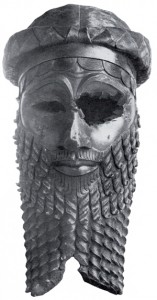
The Evolution of Armies
The evidence spans a period of at least a thousand years, from as far back as 3000 BC to the end of the Sumerian era around 2000 BC. Within this timespan we can distinguish four main phases of military development:
- The Uruk period before circa 3000 BC. During this time Uruk was the pre-eminent city and Sumerian civilisation spread outwards over a wide area of the ancient Middle East resulting in the widespread rise of cities. The core region was Sumer, which is Southern Mesopotamia. Writing was a fairly new idea and records are sparse and mainly comprise economic texts. The earliest cities were ruled by priest-governors on behalf of the patron god. The rapid expansion of agriculture and consequent rise in population resulted in a crisis towards the end of this phase, leading to the beginnings of warfare between rival cities. The proper organisation of farming land and access to marginal ‘steppe’ land and water were vital to survival in this region. Irrigation canals were dug across Sumer demarcating the territories of different cities. A crucial region was the land of Akkad, located to the north of Sumer where the Tigris and Euphrates rivers flowed close together. Control of this area led to Kish becoming the leading city for a time.
- The Early Dynastic period from circa 3000 BC to circa 2300 BC. This is the phase when armies are organised in every city, and military development is rapid due to frequent conflict between them. As the name suggests, we know of several dynasties that existed during this time. Most notable were rulers of Ur, Uruk, Lagash, Umma, Kish, Sharrupak, Nippur and further afield; Susa, Mari, Ebla and Hamazi. At this time, city-states were frequently engaged in hostilities over territory. Every so often a city would gain a temporary ascendancy, referred to as ‘kingship’. The new title of Lugal, usually translated as ‘king’ but literally meaning ‘Great Man’, was originally applied to a war leader who vanquished another city. Sometimes, several cities acted together in temporary alliance. A city was now ruled by a Lugal because it needed a commander for its army. It was no longer enough just to call up the tenants of temple lands and send them out with slings. A city needed a proper standing army, or at least a war leader with his household troops, always ready, and which could be augmented by militia. The records of this time are full of variations of Sumerian terms for ‘soldier’ as if the scribes were trying to get a grip on this new profession. Alongside this organisational development came technological innovation and new methods of fighting. The most striking of these was the close formation of infantry and the rapid, if rickety battle-cart drawn by wild asses. Chariots appeared early in this period, as shown by depictions on pottery. One of the best-documented and most studied wars of this period is the border conflict between the cities of Lagash and Umma, which lasted on and off for 100 years.
- The Akkadian Empire from circa 2300 BC to 2100 BC. This was the empire created by the conquests of Sargon, the king of Akkad. The land of Akkad and the Akkadian language are actually named after the city. This was a time of big armies that combined troops from many city-states and out-lying kingdoms. Towards the end of the preceeding phase, successful commanders, such as Lugalzagesi of Uruk, had managed to subjugate several rival cities to create a temporary empire. It was Sargon, an inspired commander of obscure origins, who seized power in the city of Kish and went on to vanquish Lugalzagesi and conquer all of Sumer. He founded the city of Akkad (or Agade) after which the land of Akkad is named. In further campaigns he established a widespread empire, extending well beyond Sumer and Akkad. His successors in the Dynasty of Akkad held on to these conquests and expanded the empire despite rebellions. At its furthest extent, the Akkadian Empire stretched from the Persian Gulf to the Mediterranean Sea and beyond into Anatolia. A new name had to be found to describe an imperial king and this was ‘Ruler of the Four Quarters’. Efforts were begun to introduce new methods of governing such a wide realm in order to counteract the tendency of cities and tribes to reassert independence at every opportunity. Akkad became a powerful capital, but in due course the empire began to crumble. The Sumerian cities were determined to win their independence. Akkadian governors were ousted in favour of rebel rulers, leading to the need for frequent re-conquest by Akkadian kings. Ultimately it was climate change in the form of increasing aridity in upper Mesopotamia, combined with the incursions of barbarous Gutian tribes from the Zagros Mountains in Iran, which brought down the empire. One notable military development during this phase was the increasing use of the powerful composite bow.
- The Third Dynasty of Ur from circa 2100 BC to circa 2000 BC. In the chaotic aftermath of the fall of Akkad, the Sumerian cities – especially Uruk and Ur – fought back against the Gutians and ousted their chief from power. Initially, Utu-Hegal of Uruk defeated the Gutian king Tirigan in a well-reported campaign in which the Gutian king fought from a chariot. Utu-Hegal’s ally was Ur-Nammu of Ur. After gaining the kingship of Sumer and Akkad, Ur-Nammu established the Third Dynasty of Ur (Ur III). Ur-Nammu and his successor Shulgi created a new ‘Sumerian’ Empire that was almost as extensive as the former Akkadian Empire. A huge effort was made to organise and standardise throughout the land, probably in reaction to the same factors that had caused the Akkadian Empire to crumble. The maintenance of road networks, transport and supply were emphasised. The new empire has sometimes been compared to a ‘communist regime’ because most subjects were employed by the state and owed state service. A huge number of bureaucratic texts survive from this time, some of which document military organisation and campaigns. The different elements of Sumerian and Akkadian armies continued to evolve. An important development included the increased use of tribal and foreign auxiliaries including Amorites, Gutians and Elamites. Another development was the appearance of the horse, known as the ‘foreign ass’, although they were rare and their use limited to a few despatch riders or as another potential draught animal for battle-carts. The kings of Ur built a long wall dividing upper Mesopotamia from Sumer and Akkad called Muriq-Tidnum. This was supposed to keep out Amorite nomads (known as Martu and Tidnum). Elam was put under a governor or viceroy. These measures did not save the empire. A general reported that the Amorites had outflanked the wall by going through the highlands to invade Lower Mesopotamia, disrupting agriculture and causing famine. At this point the king of Simashki, a land to the north of Elam, seized power in Elam, asserted independence, invaded Sumer and finally sacked Ur itself.
Technical Note
In this brief outline I refer to the conventional dating as used in most books. The chronology of the whole period is as yet uncertain, with several hypothetical chronologies being investigated and debated by scholars. I favour the shorter chronological schemes, which if correct could reduce the dates given here by at least 100 years. This era in Mesopotamia is contemporary with the Old Kingdom, the ‘pyramid age’ of Egypt, and in any revised scheme the dating of both would change in tandem. Severe drought probably played a part in the fall of the Akkadian Empire, which suggests that this happened around the same time as the collapse into anarchy of the Egyptian Old Kingdom, also a time of drought and famine.
In the more technical sections that follow, I have delved into all kinds of primary sources and academic articles to gather enough information to hypothesise what an archetypal Sumerian or Akkadian army was like and how it operated in battle. I expect that in reality every army was subtly unique, especially given the time span and geographical extent we are exploring. Some details that we might think were typical might have been specific to one conquering city rather than its defeated foes. The tactics and organisation of armies could have been as varied among the Sumerian city states as it was among the Archaic Greek or Italian Renaissance city states, within the possibilities of the age. Sumerian and Akkadian terms are both given in italics, and I have chosen not to put the Sumerian into capitals as is the convention in academic articles. The scribes who wrote about these armies used both languages.
View our full Early Bronze Age range of models:

